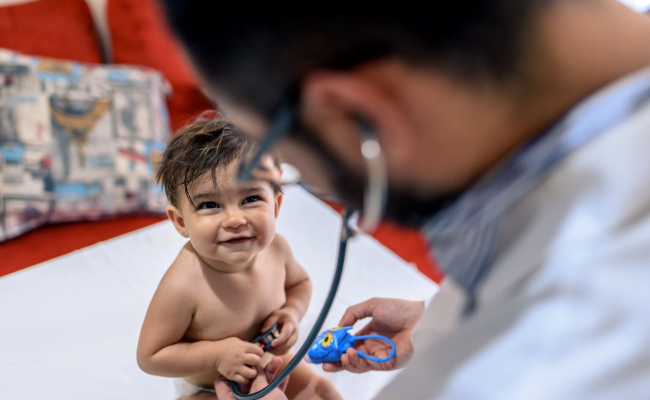Congratulations! You’ve just welcomed a new baby into your world, and with it, a multitude of questions. The very first pediatrician visit is an exciting and, often, an anxious experience for new parents. But don’t fret; here’s a comprehensive guide on what to expect at that all-important first visit. By the end, you’ll have a better idea of the milestones to watch for in your baby’s development and health.
Hello, Baby’s Doctor! Building Trust Early On
Your baby’s doctor will be an essential figure in your child’s growth and development. From monitoring your child’s weight to ensuring they’re meeting developmental milestones, they are your go-to for all concerns related to your baby’s health. This first visit is an excellent opportunity for you, the primary caregiver, and other primary caregivers, to build a rapport with the doctor. It will lay the foundation for many well-child visits and, sometimes, unexpected sick visits.
Baby’s Head: More Than Just Cute
The softness of a baby’s head often captivates new parents. But did you know it’s also an essential focus for the doctor? During the first pediatrician visit, expect the doctor to measure your the circumference of their head. It gives insights into the baby’s brain growth and development. Two main soft spots, or “still soft fontanel,” may feel unsettling, but they’re crucial for the baby’s rapidly growing brain.
Additionally, how the baby holds its head and neck, and any flat spots that might develop from sleeping in one position, will also be of interest. It’s not just about how cute the baby’s face looks, but about ensuring proper growth and development.
The Not-So-Talked-About Sudden Infant Death Syndrome (SIDS)
Every new parent anxiously scans through resources, books, and blogs, seeking guidance on caring for their new baby. Yet, there’s a topic that, due to its sensitive nature, often takes a backseat but is of paramount importance: Sudden Infant Death Syndrome or SIDS.
During your first doctor’s visit, it’s common for the doctor to broach this subject. As daunting as it might sound, knowledge is power. And in the case of SIDS, understanding the risk factors and preventive measures is the key to ensuring your baby’s safety.
So, What Exactly Is SIDS?
SIDS is an unexplained, sudden death of an otherwise healthy baby under one year of age. It’s often associated with sleep and can happen without warning. It’s every parent’s worst fear, but fortunately, due to extensive research and preventive measures, the occurrence has declined significantly over the years.
How Can New Parents Reduce the Risk?
- Safe Sleeping Position: Always place your baby on their back to sleep. This position ensures that the baby’s airway remains open, reducing the risk of suffocation. Whether it’s nap time or nighttime, the back is the safest position for most newborn babies.
- Create a Safe Sleep Environment: Ensure the baby’s sleep surface is firm, like a mattress in a safety-approved crib, covered by a fitted sheet. Keep soft objects, toys, and loose bedding out of the baby’s sleep area to prevent any obstruction to their breathing.
- Room-Sharing without Bed-Sharing: While it’s tempting for new moms and dads to share a bed with their baby, it’s safer to place the baby’s crib or bassinet in the parent’s bedroom for the first six months to a year. This proximity allows you to monitor your baby’s sleep, feeding schedules and ensures they’re safe.
- Avoid Overheating: Dress your baby in sleep clothing, such as a one-piece sleeper, and avoid using blankets. A room temperature that’s comfortable for adults is typically suitable for babies.
- Breastfeed if Possible: Studies suggest that breastfeeding can reduce the risk of SIDS. Even if it’s just for the first few months, the benefits are substantial.
- Regular Pediatrician Visits: Regular baby checkups ensure that your baby is healthy and hitting all their developmental milestones. The pediatrician can also offer advice, on your first baby checkup, on any concerns, from the baby’s feeding to sleeping patterns.
- No Smoking: Ensure that the baby’s environment is free from smoke. Secondhand smoke increases the risk of SIDS. Parents should discourage visitors from smoking around the baby and avoid places where people are smoking.
The Well Baby Visit: What’s on the Agenda?
The primary aim of the first well-baby visit is to monitor your baby’s general health and ensure they are on the right track. Here’s a breakdown of what’s typically covered:
- Physical Exam: The doctor will examine the baby’s entire body. They will check the baby’s pulse, reflexes, and hips to rule out hip dysplasia, and the still-soft fontanel on the baby’s head. They’ll also ensure the umbilical cord is healing well.
- Feeding and Digestion: Baby eating patterns, from how the baby latches when breastfeeding or bottle-feeding to the baby’s poop, will be discussed. This might also be when you discuss when to introduce solid foods and the signs that your baby’s digestive system is working correctly.
- Sleep: Baby sleep patterns will be discussed. The doctor will want to know how many naps they take, how long they stay asleep, and any concerns you might have about sleeping patterns.
- Vaccinations: Most babies get their first hepatitis B shot before leaving the hospital. The doctor will discuss this and the schedule for other upcoming vaccines.
- Growth and Development: The doctor will evaluate the baby’s weight, head circumference, and overall development. They’ll also inform you about the milestones to watch for, such as the baby’s first smile or when most babies start rolling over.
Prepping for the Visit
Remember, preparation is key to making the most out of the doctor appointment. So, what should you bring?
- Diaper Bag Essentials: Pack extra diapers, feeding supplies, and a change of clothes. You never know how many diapers you’ll go through in the waiting room!
- Insurance and Medical History: Don’t forget your insurance card. Also, be prepared to discuss any health conditions in the family that the doctor should be aware of.
The Doctor and Baby Relationship: Building a Healthy Future
Your baby’s doctor will play a pivotal role in your baby’s life. The first doctor appointment is just the beginning. It’s where trust is built, concerns are addressed, and you get clarity on your baby’s health. With routine visits, you’ll witness your baby’s development, from how the baby develops motor skills to their first attempt at solid foods.
Closing Thoughts
The first pediatrician visit is a blend of excitement, curiosity, and sometimes, anxiety. But equipped with the right knowledge and a friendly pediatrician, it becomes a memorable milestone in your baby’s life.
Always remember that no question is too small when it comes to your baby’s health. Make a list, discuss your observations, and ensure you know the date of the next appointment. Here’s to the beginning of a beautiful journey of well-baby visits and watching your precious one grow!
Your Partner in Parenthood: Powers Pediatrics
Navigating the wonders and challenges of parenthood? Don’t do it alone! Powers Pediatrics is here to support every step, every milestone, and every question along the way.
Why Choose Powers Pediatrics?
From the first well-baby visit to those crucial developmental checks, our dedicated team prioritizes your little one’s health and happiness. We blend expertise with empathy, ensuring your child receives not just medical care but a holistic health experience.
Embark on the Journey with Confidence!
No concern is too small, no question too trivial. Together, let’s ensure the best start for your baby and peace of mind for you.


